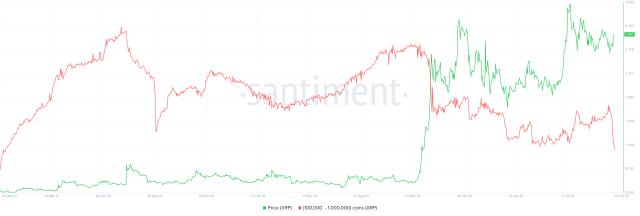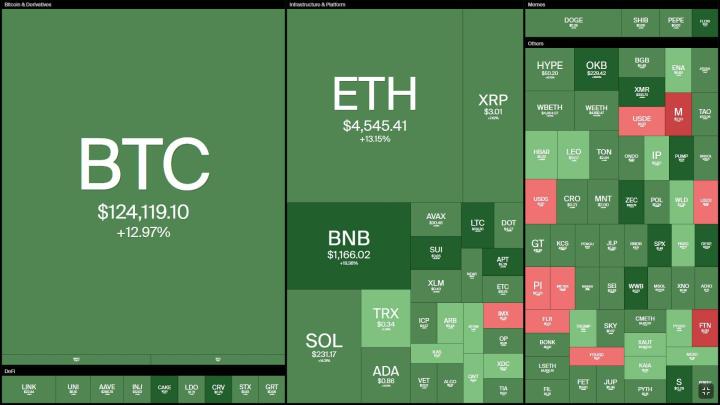Compiled by Felix, PANews(Edited and edited)
The global economy is undergoing a structural transformation. With the acceleration of digitalization and the penetration of artificial intelligence into critical value-added workflows, infrastructure has never been more crucial. Today, industries across all industries must manage critical assets, decisions, and processes that impact billions of dollars in an opaque environment. At this inflection point, verifiability has become a defining criterion for trust. The demand is clear: businesses, regulators, and end users demand proof—not just empty promises—that digital processes are executed correctly, securely, and compliantly.
Yet, despite this rapid growth, a fundamental gap remains: there is currently no purpose-built network capable of operating at the scale of global payments with the necessary security, efficiency, and regulatory sophistication to rival or even surpass traditional financial and corporate infrastructure.
While today's public chains have demonstrated verifiability in narrow, asset-centric scenarios, verifiability remains largely unattainable across the broader application stacks of traditional industries. The significance of verifiability extends far beyond cryptocurrency, encompassing cloud, payments, enterprise software, and artificial intelligence. With its differentiated product portfolio and first-mover advantage, EigenCloud is poised to extend its lead in shared security and capture a vast, underserved market. With early certification and established distribution channels, it is uniquely positioned to expand verifiability infrastructure globally across payments and other sectors.
EigenCloud : Scalable, Programmable Verifiable Infrastructure
EigenCloud aims to build a foundational platform for programmable verifiability: a unified stack that integrates data availability, dispute resolution, and verifiable off-chain computation into a seamless developer experience. At its core, EigenCloud leverages the EigenLayer architecture to modularize cryptoeconomic trust, enabling complex verification workflows to be implicitly bundled into a single, easy-to-use process. The result is a developer-centric platform that makes verification not only possible, but also composable and scalable across industries, applications, and infrastructure layers.
Unified Verifiability Stack
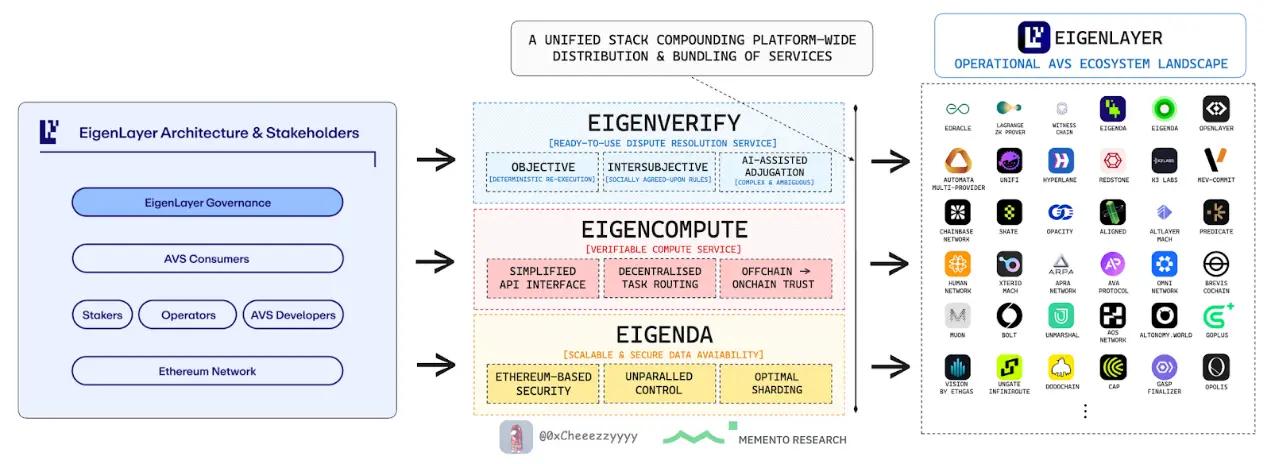
Eigenlayer complete architecture stack
EigenCloud is more than just a collection of primitives; it's a coherent verifiability infrastructure. Each of its core modules addresses a key bottleneck in the verifiability lifecycle. All modules, however, interoperate natively within the same framework:
- EigenDA (Data Availability): Provides durable, high-throughput storage for inputs and outputs, enabling independent re-execution and transparent audit trails. Immutable commitments form the basis for reproducibility and challengeability.
- EigenVerify (Dispute Resolution): Provides dispute resolution as a service, including objective re-enforcement, inter-party consensus, and even AI-assisted adjudication. All outcomes support recourse, ensuring that disputes are finally resolved and financially binding.
- EigenCompute (Verifiable Off-Chain Computation): Serves as a verifiable container orchestration layer, with workloads executed under deterministic wrappers. Security is metered per operation, and third-party AVS can be combined through a simple, developer-oriented interface.
These modules converge into a programmable and verifiable platform layer. EigenCloud unifies these fragmented primitives into a flexible, cloud-native function that can be directly embedded into existing systems, eliminating the need for developers to piece them together.
Implicit bundling
Given EigenCloud's design and architectural foundation, its significant advantage lies in implicit bundling. By unifying data availability, dispute resolution, and verifiable computation in a single stack, EigenCloud provides an end-to-end verification workflow that is seamless by default. This means developers no longer need to manually piece together isolated primitives or manage fragile integrations. Each module naturally flows into the next: data is submitted, claims are anchored, challenges can be raised, and disputes are resolved—all within a coherent flow.
As a result, external applications can flexibly integrate any or all of EigenCloud's modules based on their needs while still benefiting from the assurances of the entire stack. Implicit bundling transforms verifiability from a piecemeal practice to a cloud-native capability that is easy to adopt and powerful enough to support mission-critical operations.
Highly compatible developer ecosystem
Furthermore, EigenCloud isn't designed just for cryptographers or protocol engineers. It's designed for maximum inclusiveness. By lowering the barrier to integration, EigenCloud empowers developers in Web3, enterprise, and AI to embed cryptoeconomic trust where it's needed most.
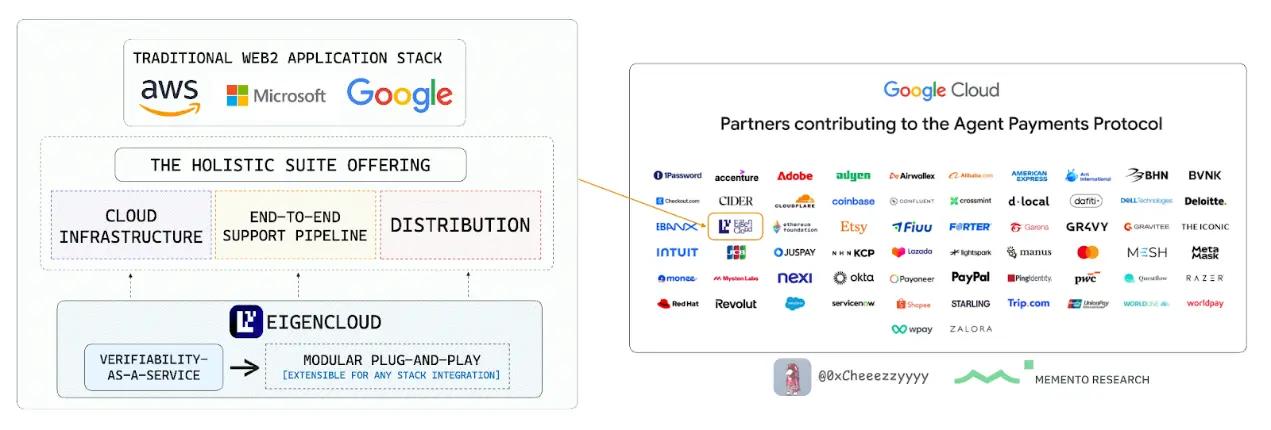
Its value proposition is twofold:
- Simplified end-to-end integration for Web3 developers: EigenCloud provides an end-to-end integration path to minimize the learning curve. Developers can directly access verifiability primitives without having to rearchitect their stack. Monitoring and development tools are built into the AVS DevKit, composable middleware, and orchestration tools.
- Modular and scalable for any technology stack: For non-crypto applications, EigenCloud provides modular plug-and-play components. Teams can selectively integrate verifiability in any form factor within their native technology stack without requiring a full migration. This approach aims to bring cryptographic-level trust to both traditional and native AI environments while maintaining architectural flexibility.
This inclusiveness is reinforced by strategic partnerships. Google's new Agent Payment Protocol (AP2) marks a major step forward in establishing AI agents as meaningful economic actors. EigenCloud provides a verifiable infrastructure, ensuring these agents are accountable to any counterparty by embedding VaaS into broader distribution channels and workflows.
By combining these two approaches, EigenCloud becomes a universal foundation for verifiability: easy to use for Web3 native applications, yet equally attractive to enterprises, AI developers, and traditional software builders.
Closing the Loop: Making Programmable Verifiability Practical
By combining modular primitives with implicit bundling, EigenCloud transforms verification from a fragmented ideal into a practical and scalable service layer, where complex assurance processes are simplified into a single developer process and trust is composable, programmable, and monetizable across all domains. Therefore, EigenCloud is not only an infrastructure innovation but also a gateway. By making verification accessible to all builders, it redefines a fundamental expectation of digital infrastructure: outcomes are secured by proof, not promises.
Distribution, Coordination, and the Flywheel
Its structural lead is underpinned not only by architectural innovation but also by distribution, first-mover advantage, and self-reinforcing network effects that accumulate scale over time.
At the center of this flywheel is $EIGEN, a native cryptoeconomic asset that aligns the interests of stakers, operators, developers, and enterprises, and represents the rise of programmable trust.
Differentiated market segments and distribution advantages
EigenLayer is the first platform to pioneer shared security, formally establishing the new "Trust as a Service" category and spawning the re-staking market, which is now worth $28.9 billion.
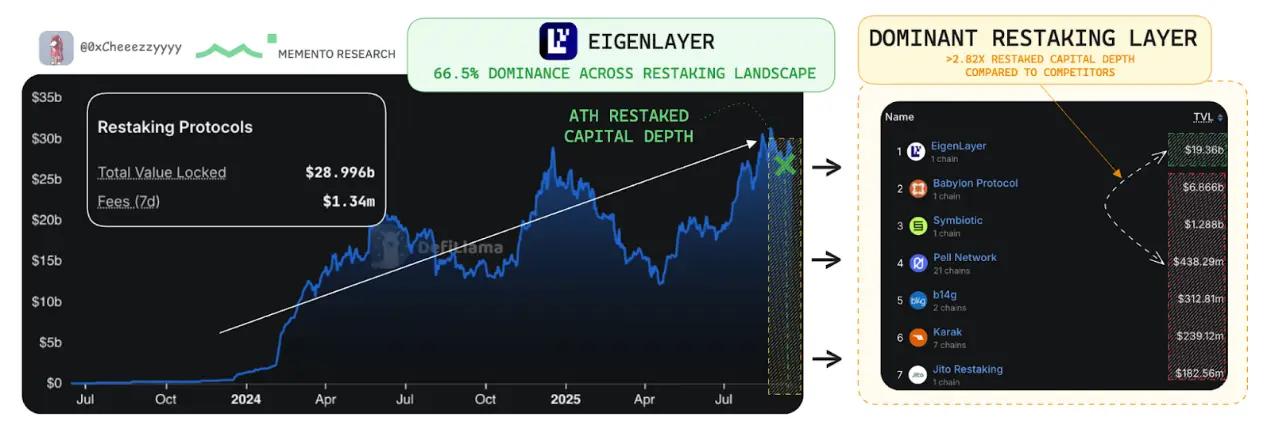
This early innovation not only enables novel use cases but also provides immediate integration and access to capital. EigenLayer holds approximately 66.5% of the re-staking market share, securing nearly $20 billion in Ethereum collateral across over 60 AVS ecosystems. This dominance is driven by long-standing credibility, proven infrastructure, and deep ecosystem support.
Unique dual distribution moat and asymmetric potential
EigenLayer's structural advantage lies in its unique double moat.
- Security as a Service (SaaU): EigenLayer provides a strong shared security foundation, formalizing ETH restaking as a general utility for AVS. This ensures that each new service inherits the security depth without having to rebuild trust from scratch.
- Verifiability as a Service (VaaS): EigenCloud extends this model by allowing applications to “rent” verifiability budgets across EigenDA, EigenVerify, and EigenCompute. This turns cryptoeconomic guarantees into a consumable service.
This dual distribution creates an asymmetric growth curve. Each new AVS (whether an oracle, bridge, inference engine, or compliance service) enriches the types and choices of verifiable workflows.
As developers build these services, time to market decreases, adoption grows exponentially, and EigenCloud becomes the default backend platform for verifiable applications.
The network effect flywheel
This dual foundation kick-starts two mutually reinforcing flywheels: (1) security-driven adoption and (2) verifiability-driven distribution, which together solidify EigenLayer’s dominance.
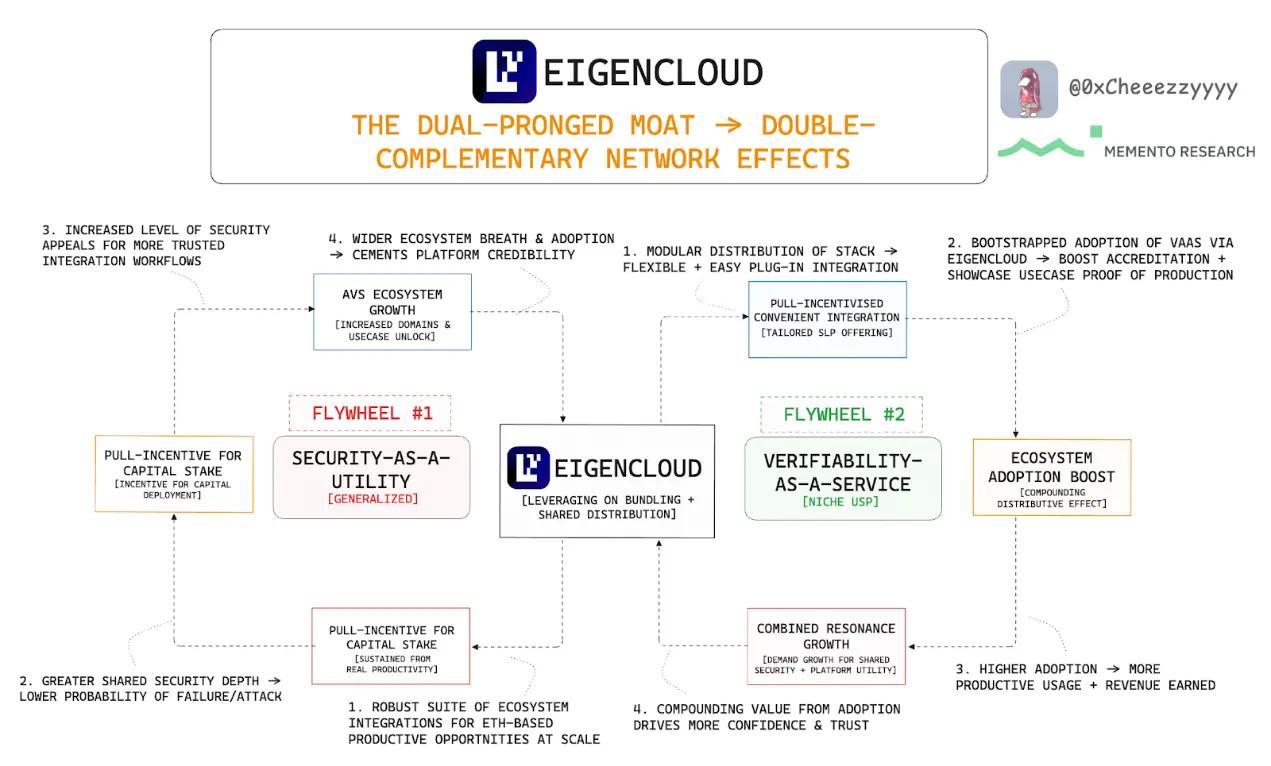
Flywheel 1: Safety-Driven Adoption
This is the core growth engine of EigenLayer:
1. Re-staking funds → Shared security pool
When ETH is redeposited on EigenLayer, it flows into a secure pool that any AVS can access. Instead of building their own validator set or establishing trust from scratch, new services can immediately inherit the trustworthiness of Ethereum, positioning EigenLayer as a universal market where security itself becomes a ready-made utility.
2. Reduce risks and costs → Drive AVS integration
The deeper the security pool, the lower the probability of AVS being attacked or failing. This reduces both economic risk and operational costs, making EigenLayer an attractive hub for new services to deploy. Developers are drawn to EigenLayer not because they don't have to compete for scarce validators, but because it minimizes the burden while providing Ethereum-level security.
3. Expanded functionality → More applications and liquidity
As more AVSs join, they bring specialized capabilities and enhance the composability of the ecosystem. This broader toolkit attracts applications and liquidity providers that prefer to build in the richest and most diverse infrastructure environments, thereby amplifying EigenLayer’s role as an innovation hub.
4. Stronger operator economics → More stakers → Higher security
Each new application joining the ecosystem generates transaction fees and rewards, strengthening the economics of the operators. Higher returns attract more stakers, expanding the ETH security pool and further enhancing the platform's resilience. This creates a self-reinforcing cycle: adoption increases security, and greater security drives adoption, solidifying EigenLayer's position as a shared security layer.
Flywheel 2: Verifiability-driven distribution
Building on this secure foundation, EigenCloud drives the second reinforcing flywheel. By bundling verifiability into applications and leveraging EigenLayer’s existing network state, it accelerates distribution while enhancing authentication for applications beyond DeFi.
1. Modular distribution → rapid adoption
EigenStack and EigenCloud allow projects to tap into Ethereum’s validator base and existing distribution channels, thus avoiding the cold start problem. Instead of slowly bootstrapping trust and usage, applications can immediately achieve scale by leveraging proven infrastructure.
2. Bundling effect → Certification trust
By embedding EigenCloud’s verifiability into application state, projects inherit the credibility and global trust of Ethereum’s validation layer. This bundling makes it easier for businesses, institutions, and regulators to integrate without having to provide a separate track record for each new service.
3. Accelerate Integration → Composite Adoption
Each new integration into the EigenCloud stack strengthens the ecosystem’s appeal and credibility. Adoption continues to grow and network momentum builds as developers, enterprises, and institutions gather around a common validation layer.
4. Metcalfe Resonance → Consolidation Beyond DeFi
As adoption increases across more services, EigenLayer's network effect resembles Metcalfe's law, where value grows exponentially with each additional integration. This not only makes EigenLayer the most powerful shared security layer, but also creates a bundled capability for universal programmable verifiability.
Fusion synergy
These two flywheels intertwine to drive exponential growth: re-staked ETH supports shared security, attracting AVS and applications, while EigenCloud accelerates verifiability and distribution into new markets. Security at scale makes applications viable, and verifiability at scale makes them trustworthy. The two complement each other, forming a two-pronged system where each loop reinforces the other.
$EIGEN : Ecosystem Value Capture
At the core of EigenCloud is the verifiability token, $EIGEN. It underpins the system by securing the AVS, supporting dispute resolution, and monetizing programmable verifiability. Unlike utility tokens tied to specific use cases, $EIGEN represents ownership of the entire verifiability economy—covering data availability, dispute resolution, and verifiable computation.
Platform positioning and scale
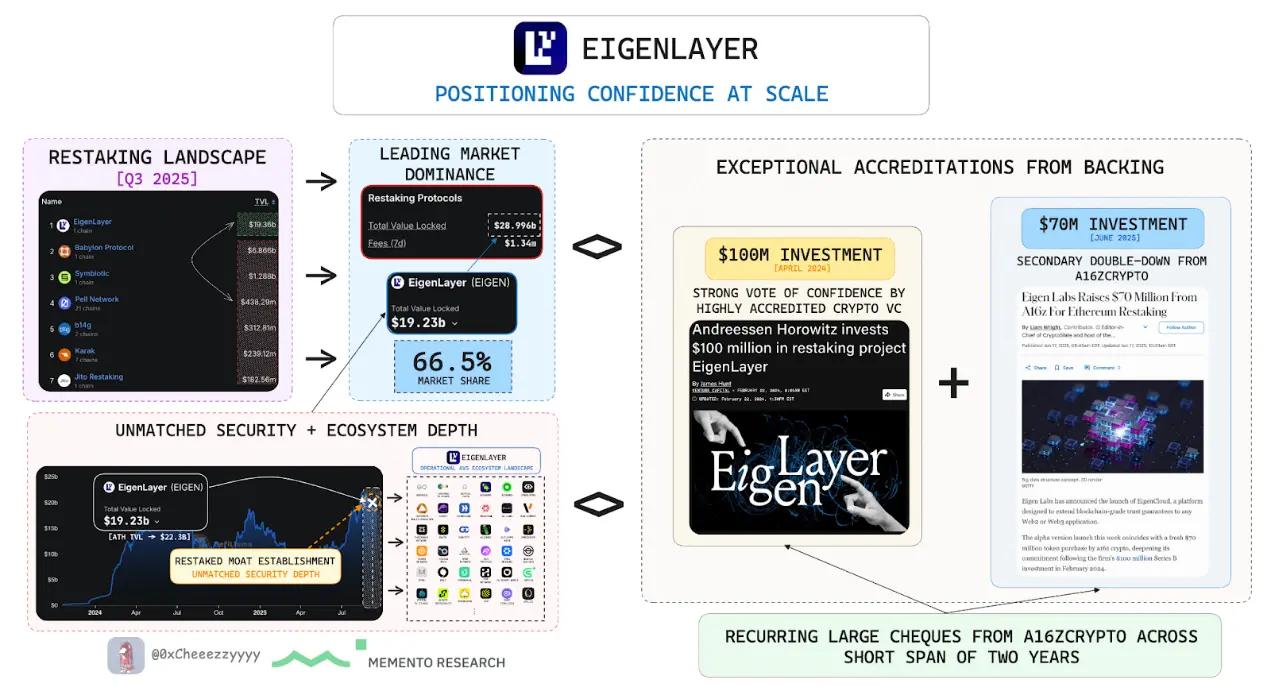
EigenLayer's dominance in shared security has laid the foundation for $EIGEN within the industry, and its position is further strengthened by platform-wide certifications:
- Security and Ecosystem Depth: ~$20 billion in ETH re-staked, ensuring network security, and integrated with over 60 active AVSs, and still growing.
- Industry dominance: 66.5% market share in the re-hypothecation sector.
- Accreditation and Investor Support: Received $70 million in funding from a16z and recognized by industry leaders.
Value Accumulation: Compound Flywheel Effect
On this basis, $EIGEN continues to accumulate value through a self-reinforcing cycle. More staking expands the cryptoeconomic security pool, making EigenCloud services cheaper and more reliable.
Lower costs attract more applications (across DeFi, AI, and enterprise workflows) that embed verifiability into mission-critical operations. Fees compound as usage grows, generating a lasting revenue stream, improving operator economics and incentivizing further staking inflows.
Each cycle reinforces the next: deeper stake leads to cheaper service, cheaper service attracts more applications, applications drive usage, usage drives fees, and fees ultimately attract more capital. Over time, this dynamic solidifies $EIGEN as the economic backbone of EigenCloud.
Multi-faceted value accumulation for stakeholders
There is no doubt that the design of $EIGEN is the core of the entire ecosystem, which aims to balance and satisfy the interests of all participants.
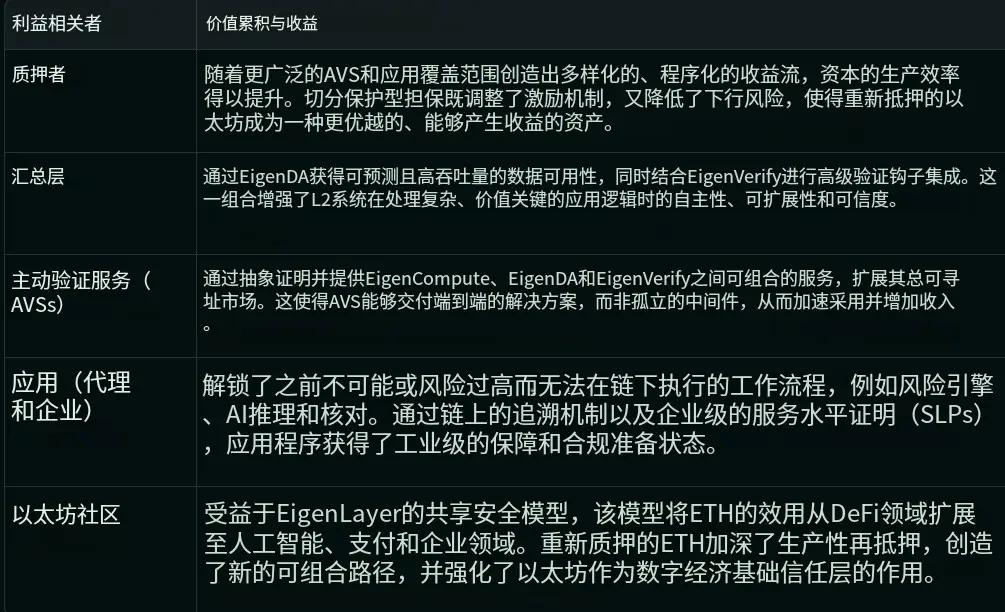
The combined interests of these stakeholders exemplify how EigenCloud transforms verifiability into a shared economy product, rather than an isolated feature. Through an inclusive incentive mechanism, the network ensures value flows in multiple directions while reinforcing the same foundation of cryptoeconomic security. This growth not only expands EigenCloud's adoption but also strengthens its defensibility.
A balanced view: uncertainty and risk
While the structural advantages are clear, EigenCloud must address a number of risks that could impact long-term adoption and defensibility.
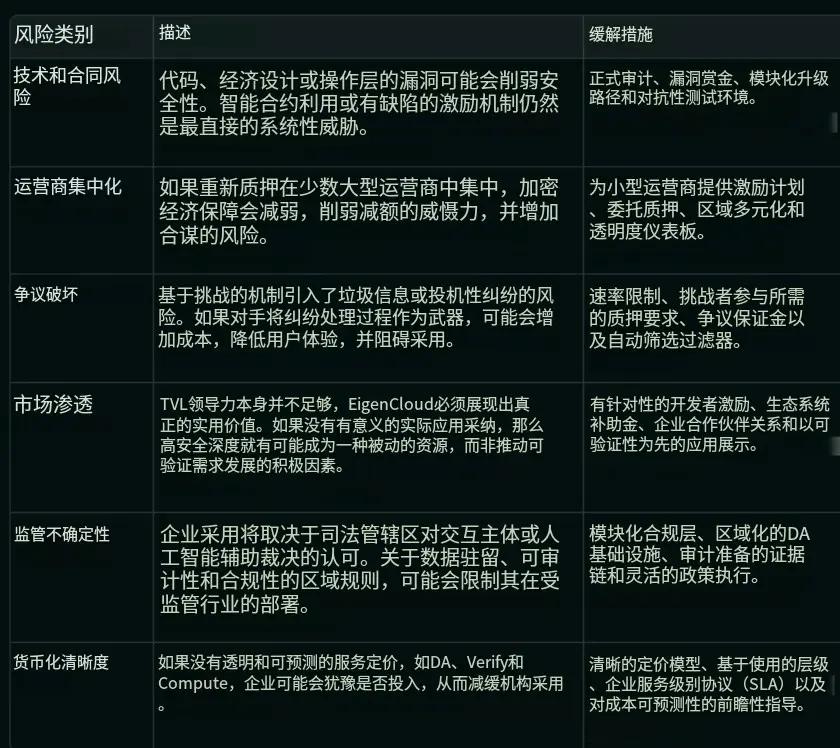
Technical risks, centralization pressures, and regulatory complexity are structural challenges that any network must address and may impact its adoption trajectory.
However, these risks are not fatal flaws, but merely obstacles that need to be overcome. The key test for EigenCloud will be its ability to strike a balance between decentralization and institutional needs, proving that the same architecture that unlocks programmable verifiability can also adapt to the operational and regulatory realities of global deployment.
in conclusion
EigenCloud redefines decentralized infrastructure by prioritizing verifiability as a first principle. Beyond shared security, they extend this to programmable, application-centric verifiability, addressing the pressing needs of AI, enterprises, and globally coordinated systems. EigenCloud transforms verifiability from a fragmented ideal into a composable, developer-centric platform.
This creates a unique dual, complementary moat for its SaaU and VaaS offerings, making EigenCloud the default trust layer. By setting a new industry standard for service-level proof, it is enabling widespread adoption across AI, enterprise, and capital markets.
At the center of this flywheel is $EIGEN, the foundational asset for the multi-trillion dollar verifiability economy and the backbone of the high-stakes digital infrastructure of the future.
Related reading: Verifiable Cloud EigenCloud: A New Paradigm for the Integration of Web2 and Web3




